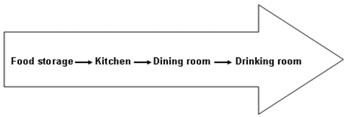11.5.4 How and what to inspect
Upon arrival at a food and drink establishment you should introduce yourself and announce politely the purpose of your inspection in order not to embarrass the owner. Interviewing food handlers, physical observation and the use of a checklist are the main tools for data collection. Information is also collected by interviewing the owner and the food handlers. The sanitary inspection checklist in Appendix 11.1 can be used for subsequent visits as well as the baseline survey.
The inspection starts by checking the physical presence of latrines and handwashing facilities meant for the clients. The inspection is based on the food preparation flowchart and is carried out in a sequential manner: food storage, kitchen, dining room and drinking rooms (Figure 11.7).

The handling of raw food is inspected in the food storage room. The use of refrigerators for perishable food items (meat, eggs, juice, fruits and vegetables) is checked. Semi-perishable foods such as potatoes and onions need to be stored on shelves that are properly ventilated and free from any vectors.
In the kitchen the use of detergents, the presence of three dishwashing bowls (or a sink with running water) and the practice of personal hygiene must be closely checked. There should be no vectors such as flies and cockroaches in the kitchen area. The food handler’s health is rapidly checked by doing a physical examination for the presence of active infections (skin, eye, ear infections or nasal discharges). The proper use of apron, gown or overalls, hair cover and appropriate footwear by the food handler is also investigated.
The strict separation of kitchen tables for cooked food items and raw food needs to be inspected. The presence of obvious indoor air pollution is also important to note.
In the dining room, the condition and cleanliness of the tables, chairs, floor, walls and ceiling should be observed. The presence of vectors and proper waste management facilities must be inspected in all parts of the food processing and serving areas. The proper handling of kitchen waste in a garbage container, and the presence of a waste bin in dining areas, should be checked.
As you make your inspection, record the information on the checklist. Do not write much on the checklist while inspecting because the owner may not be comfortable about it. Pay attention to critical situations such as dishwashing practice, handwashing practice, vectors and waste handling.
11.5.3 Informing the owners about the sanitary inspection
